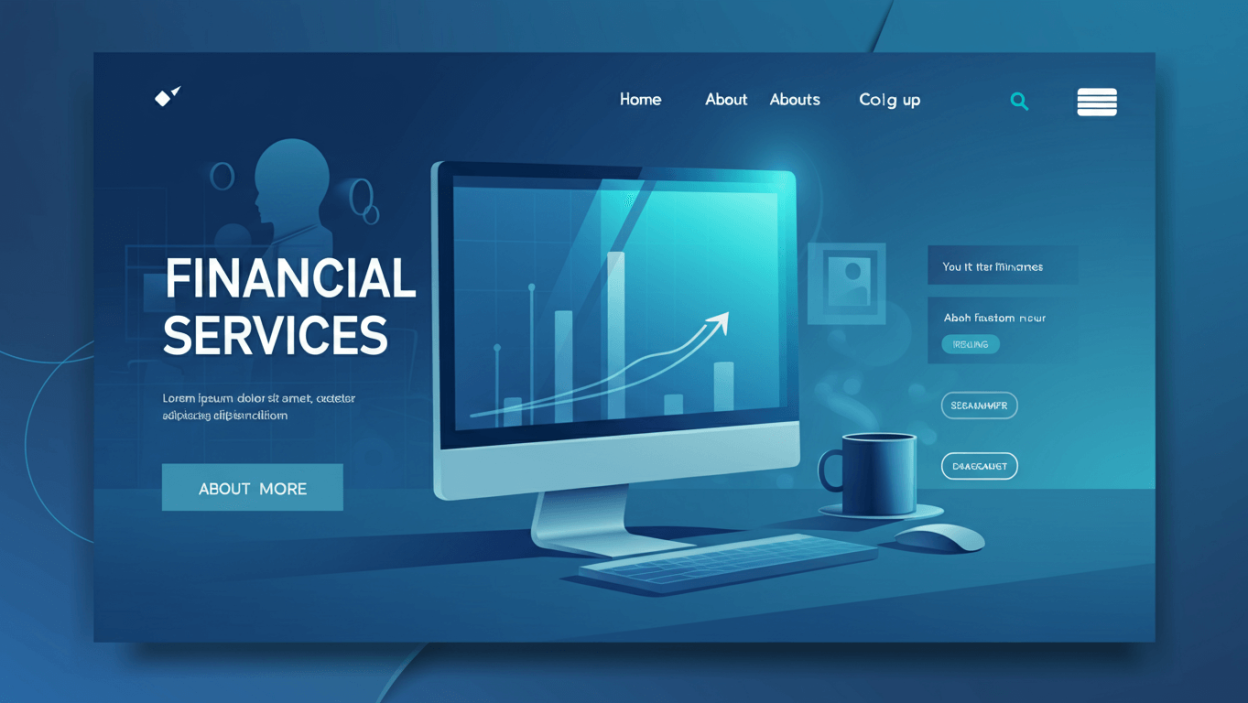Financial services companies face a unique challenge when designing their websites. Unlike other industries where flashy visuals and trendy layouts may be compelling, financial institutions must strike a balance between modern aesthetics and trustworthiness, security, and regulatory compliance. Your website often serves as the first point of contact between your firm and potential clients, making decisions about website design for financial services critical to business success.
The stakes are particularly high in the financial services sector. Visitors to your website are considering entrusting you with their most valuable assets—their money, investments, and economic future. A poorly designed website can immediately undermine confidence, while a well-crafted one can establish credibility before the first conversation even begins.
This guide examines the key components of effective website design for financial services, encompassing the creation of trust through visual elements and adherence to industry regulations.
Understanding Your Financial Services Audience

Financial services websites serve diverse audiences with varying needs and comfort levels with technology. Younger clients may expect sleek, mobile-first experiences similar to those found in fintech apps. In contrast, older, more traditional clients often prefer straightforward, information-rich layouts that prioritize clarity over creativity.
Your design should accommodate both demographics without alienating either group. This means creating intuitive navigation that doesn’t require extensive technical knowledge while incorporating modern elements that demonstrate your firm’s forward-thinking approach.
Also consider the emotional state of your visitors. People researching financial services often face significant life events, such as retirement planning, major purchases, or financial difficulties. Your website design should convey stability and competence while remaining approachable and empathetic.
Essential Design Elements for Financial Websites
Professional Colour Schemes and Typography
Colour psychology plays a crucial role in the design of financial websites. Blues and greens traditionally convey trust, stability, and growth—qualities clients seek in financial partners. However, this doesn’t mean every financial website should look identical. Subtle variations in shade, accent colours, and complementary hues can create distinctiveness while maintaining professionalism.
Typography choices are equally important—clean, readable fonts like Helvetica, Arial, or custom sans-serif typefaces project modernity and clarity. Avoid decorative fonts that might appear unprofessional or difficult to read across different devices and screen sizes.
Precise Navigation and Information Architecture
Financial websites often contain vast amounts of information, including services, resources, regulatory disclosures, and educational content. Organising this information requires careful planning and a clear hierarchical structure.
Your main navigation should reflect how clients perceive their financial needs, not how your organisation is internally structured. Categories like “Personal Banking,” “Investment Services,” or “Business Solutions” are more intuitive than department-based navigation.
Implement breadcrumb navigation for deeper pages and ensure that your search functionality can handle financial terminology that clients may use when searching for specific services or information.
Building Trust Through Design

Trust is the cornerstone of financial services, and your website design should reinforce this at every touchpoint. Several design elements contribute to establishing credibility online.
Display professional certifications, regulatory compliance badges, and industry memberships prominently. These visual indicators immediately communicate legitimacy to visitors who may be unfamiliar with your firm.
Client testimonials and case studies, when presented thoughtfully, can build confidence in your services. However, ensure that these elements comply with the regulatory requirements regarding client privacy and testimonial usage in your jurisdiction.
Security indicators deserve special attention on financial websites. SSL certificates, security badges, and clear privacy policies should be visible and easily accessible. Many visitors will specifically look for these elements before engaging with your site.
Mobile Optimisation for Financial Services
Mobile traffic continues to grow across all industries, and the financial services sector is no exception. However, mobile optimisation for financial websites requires special consideration due to the sensitive nature of financial information and the complexity of many financial products.
Responsive design ensures your website functions correctly across all devices, but proper mobile optimisation goes beyond basic responsiveness. Consider how forms, calculators, and interactive tools translate to smaller screens. Complex mortgage calculators or investment planning tools may need simplified mobile versions or alternative presentations.
Security becomes even more critical on mobile devices. Ensure that mobile users can easily identify secure connections and that sensitive functions require appropriate authentication measures.
Compliance and Accessibility Considerations
Financial services websites must comply with numerous regulations that affect design decisions. The Americans with Disabilities Act (ADA) requires websites to be accessible to users with disabilities, which impacts everything from colour contrast ratios to keyboard navigation.
WCAG (Web Content Accessibility Guidelines) provides specific standards for financial websites. These include requirements for alternative text on images, proper heading structures, and sufficient colour contrast. Compliance isn’t just about avoiding legal issues—accessible design creates better experiences for all users.
Regulatory disclosures and legal requirements often mandate specific placements of information or warnings. Work these requirements into your design from the beginning rather than treating them as afterthoughts that disrupt the user experience.
Measuring Design Success
Effective financial website design should be measurable through both quantitative metrics and qualitative feedback. Key performance indicators include time spent on key pages, conversion rates for contact forms or account applications, and bounce rates from important service pages.
User testing with actual clients or prospects can reveal design elements that create confusion or undermine confidence. Regular testing and refinement ensure your website continues to serve your business objectives as both technology and client expectations evolve.
Creating Your Financial Services Website Strategy
Successful financial website design requires understanding your unique client base, regulatory environment, and business objectives. Begin by auditing your current website’s performance and identifying specific areas where design improvements can positively impact business outcomes.
Consider collaborating with designers who specialise in financial services and have a deep understanding of the industry’s unique requirements. Their expertise can help you strike a balance between engaging design and regulatory compliance, creating a website that truly serves your clients’ needs and builds your firm’s online reputation.








How Open Banking APIs Are Revolutionizing Digital Finance?
What Is FinTech? A Beginner’s Guide to the Finteching 2025
What Is a Fintech App? Everything You Need to Know
Why Digital Financial Services Are Transforming the Future of Finance
Digital Twin Technology in Finance: How Virtual Models Are Transforming Risk Management
The Future of Personal Finance: Autonomous Finance and AI Money Management
AI Credit Scoring: Revolutionizing SME Banking and Digital Loans
AI Fraud Detection: How Banks Prevent Financial Crime in Real Time